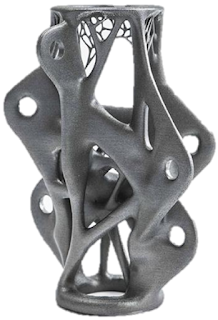FEM: Mesh quality and body simplification (Part 4) - Mesh Quality
Have ever you asked: How to check the mesh quality in FEM? What are the criteria to consider to evaluate the mesh quality? In this topic, let's brifly to explain some concepts to have a good mesh quality and how to control it.
-
Elements distribution
How much
more homogeneous is the mesh, better. It means: similar type of elements and
non-distortion of the elements shape, regular distribution, elements with
similar size and smooth transition of sizes, continuity of nodes between parts
transitions.
Figure 1 - Element distribution comparison.
At left a mesh more homogeneous and below, quantitative element quality
analysis. Most of them have more than 88% of quality criteria.
-
Elements Transition
There are some regions in the body
which a smaller element is required while for others, not so small elements are
enough. Due to this sizing difference, there are transitions regions from
smaller to bigger elements. The softer is the transition, better will be the
mesh quality.
Figure 2 - Comparison of element transition.
At left a fast transition and at right a smooth transition.
-
Node anchorage
In most of the meshing strategies,
nodes are anchored on edges and on vertexes. If there are more than two vertexes
in an edge, the nodes will necessarily consider them and a distortion on the
mesh can appear due that the node must be at this point. So, to avoid extra
elements and distortion of mesh, a continuous edge is recommended in the CAD
model.
Figure 3 - Example of nodes anchorage on an
edge and how extra vertexes disturbs the mesh.
-
Connection between bodies
Some problems made by
several bodies need to be interpreted as an only one big body (rigid, without
relative movements). In this case, the mesh must be continuous in all system
and share the same nodes (shared topology) on the edges where there are the
connections between each body.
Figure 4 - A problem when the bodies need to seem as just
only one.
Figure 5 - At left, a system without shared
topology, the mesh is generated independently for each body. And at right with
shared topology, the mesh is continuous and considers all system.
-
Mesh density in proper regions and geometry
simplification
There are some regions that cause an increment
of the mesh density. These are shaped transition regions, like fillets,
chamfers, small details, markings, holes, recesses etc. As is known, how much
small is the element size, bigger is the results accuracy, but by another hand,
more computing processing is required. The point is, that there are some
regions where we will have maximum tensions and is only in these regions that
is interesting we have accuracy and a proper mesh density (local mesh
refinement), while that a big density in other regions are not necessary.
Sometimes is not possible to know where are
these regions, so one first interaction is required to identify where is
necessary to the mesh have its density incremented or not.
Figure 6 - After the first interaction, is identified
the region of maximum tension, wherein the mesh density needs to increment.
Figure 7 - The maximum tension in just a
node is a signal that the mesh density must increase.
Figure 8 - After increased of the mesh
density, the maximum tensile is distributed by several nodes so as provide more
reliability of the result.
For other regions with low tensions, where do not need an
increment of the mesh density, bigger elements can be used without losing the
resulting quality and even increase the speed of solution with fewer elements
and nodes. It is achieved with geometry simplification, removing regions that
naturally creates small elements (fillets, chamfers, small details, markings,
holes, recesses etc), but do never remove fillets and chamfers in regions of
maximum stress as will be explained at section “Number of elements and
convergence”.
Figure 9 – The original body
created a mesh with 24813 nodes and 14525 elements.
Figure 10 - The simplified body created a
mesh with 4007 nodes and 2137 elements, resulting in an 85% reducing.
- Geometry repairs
Is important we always check the CAD
quality before do the meshing. It´s necessary because some inconsistencies or
redundancy could be in the geometry. Some examples of problems in the geometry:
gaps between surfaces or missing faces, extras vertex on edges, extra or redundancy
of edges or surfaces, some residue due CAD operations etc. There are FEM
software that identifies these problems and solve automatically. For other
situations, some manually geometry manipulation is necessary.
Figure 11 - Examples of geometry failures.
From left to right: Surface gaps, face missing and extra edges.
Figure 12 - A very small unnecessary surface
that generated small extra elements, disturbing the mesh. Probably due to
residue of CAD operations.
-
Number of elements through the
thickness
In a body
subjected to bending, there is a recommended rule that a minimum of 4 linear
elements or 2 superior order elements should have through the thickness of the
body. But if a membrane stress can be observed, with a slight change in stress
(tensile and compressive) magnitude through the thickness, only one element
through the thickness is enough. If the body has a thin wall, subject to
tensile and compressive stress on opposite sides, is recommended to reduce the
element size only in critical regions, to do not create excessive unnecessary
elements [Autodesk].
Figure 13 - For a body subjected to bending,
a minimum of 4 elements through the thickness. But witch a slight change in stress
(tensile and compressive) like right one part, only one element through the
thickness is enough. FONT: Autodesk.















Comments
Post a Comment